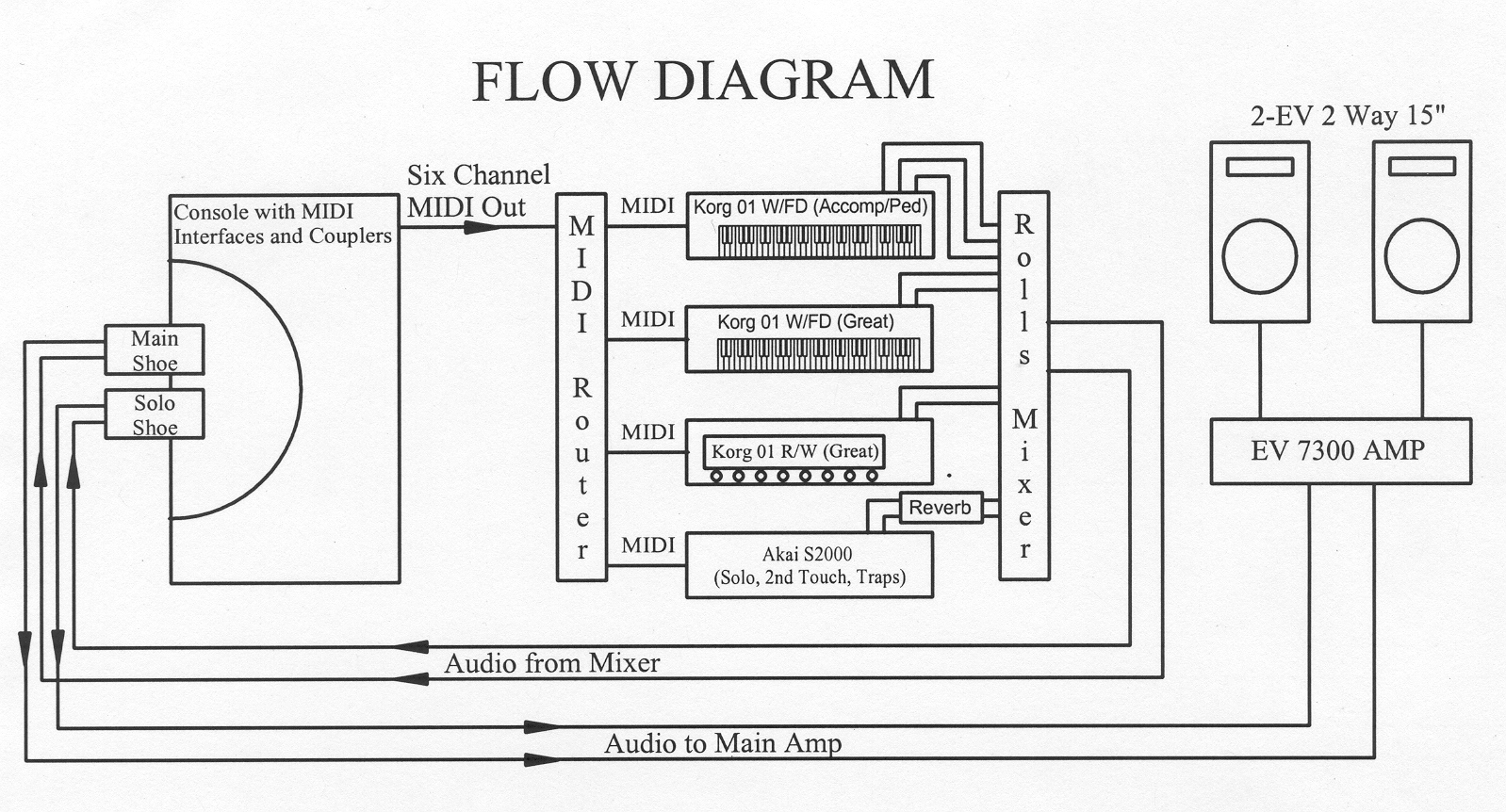CONSTRUCTION OF THE VIRTUAL THEATER ORGAN
Here's where you will find out what the real 'guts' of my instrument are all about. It helps if you are a bit familiar with MIDI setups, since MIDI
is the backbone of creating a Virtual Theater Organ.
In essence my 'organ' consists of a MIDI controller (the console) a MIDI signal router
(MIDI processor) three Korg 01 type synthesizers, an Akai S2000 sampler, a Rolls mixer and an ElectroVoice amplifier and speaker system. The three Korg units all contain an internal reverb generator and signals
are run directly to a Rolls mixer. The Akai sampler has no onboard reverb and so an Alesis Mini-Verb is placed between it and the mixer. The mixer
directly feeds the line-in of an ElectroVoice 7300 PA amplifier (200 watts RMS per channel) and this in turn feeds two 2-way ElectroVoice 15"
cabinets. That's it, no banks of processors, no jumbled collection of various sound modules of various manufacture, just a relatively small
uniform setup.
The console is one big MIDI controller disguised as a horseshoe console. It outputs six MIDI channels to the MIDI router,
which does nothing more than send the MIDI signals to each of the modules, kind of like the MIDI version of a multi-tap outlet. All the synths and
sampler volume controls are turned all the way up, and the mixers are all at the same level. Any change of level is done in the rank settings themselves.
The pipe voices for each of the sound producing modules are the same, insuring uniformity of tone and balance throughout the instrument.
The Synthesizers are permantly assigned to various divisions. There is one Korg 01W/FD covering the Accompaniment and Pedals, Another Korg 01W/FD plus a rack mount 01R/W to cover the Great which needs more polyphony for large ensembles, and the Akai S2000, loaded with rank samples from the Korgs covers the Solo manual. Because of the versitle MIDI architecture of the S2000, it is able to actually cover SEVERAL divisions when operating in its MULTI mode. In addition to providing Solo voices, this workhorse of the organ provides voices for the Accompaniment 2nd Touch, Great 2nd Touch, and all the traps and effects. The system diagram showing components, MIDI signal flow and audio signal flow is shown below:

The console has a six channel MIDI output: Pedal, Accompaniment, Great, Solo, Accompaniment 2nd Touch and Great 2nd Touch. These are combined from
the various keyboard interfaces into a single MIDI output and sent to the MIDI rack via a single cable. Once received by the MIDI router, the
signals are sent to all four of the modules. Each Korg module processes one channel depending on its manual assignment. (The Accompaniment Korg unit
also processes the Pedal input.) The Akai S2000 sampler receives channel inputs for the Solo manual, Accompaniment 2nd Touch, Great 2nd Touch and Pedal
notes above the normal pedal compass of 32 notes, up to the 49th note. These notes, although on the same channel as the Pedal division, control
individual trap samples such as bass drum, cymbal, tambourine, etc.
The console is wired in the same fashion as a Theater Pipe Organ console,
but operates on 3VDC keying voltage. This enables the use of couplers, trap lines. and other Theater Organ devices difficult to emulate with MIDI.
The 3VDC keying voltage operates resistor/diode logic which creates the manual and pedal couplers. These signals are output to banks of optoisolators
which simply close the keyswitches on the motherboards of inexpensive Casio synnthesizers. The motherboards are tricked into thinking keys are being
played. These inexpensive units make no sound, but transmit MIDI signals when the optoisolator closes their keyswitch contacts and send NO velocity signals, precisely
what is wanted for an organ. Each keyswitch had two contacts, not three as in velocity sensitive synths.
The three Korg units have reverb processing in them, and a slight bit of reverb is added for room enhancement. The Akai S2000 Sampler has no onboard effects and is fed through an Alesis microverb before it is routed to the mixer. The third audio output from the Korg unit that handles the pedals bypasses reverb entirely and is dry. This is the Pedal bass output and is sent to the mixer as a separate dry channel so that it can be distrubuted equally to the two 15" speakers. The nine channels of audio coming from the four tone generators is mixed down in the Rolls mixer to a two channel stereo mix. Audio out from the mixer is fed back to the two expression pedals at the console, then directly to the Electrovoice 7300 amp, then on to the two-way 15" Electrovoice cabinets.
OperationVirtual Theater Organ Registration Basics-Families of Theater Organ Tone
Virtual Theater Organ Registration Basics-The Tibia/String Relationships
Virtual Theater Organ Registration Basics-Esemble Registrations
Virtual Theater Organ Registration Basics-The Polphony Problem
Virtual Theater Organ Music .mp3's Email Me at steamrocks@yahoo.com